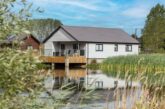
With new regulations putting both building safety and workmanship in the spotlight, Stuart Nicholson from Marley, gives advice on improving the safety and security of pitched roofing.
The publication of the Building Safety Bill, on 5 July 2021, has brought the biggest changes to building safety regulations for nearly 40 years. It ensures safety is considered at every stage of a building’s development and gives homeowners and residents more power to hold builders to account.
While the Building Safety Bill focuses on high rise buildings, it will also ensure high standards of safety in all homes. As part of the proposals, homeowners and residents will have more than twice the amount of time (from six to 15 years) to claim compensation for sub-standard construction work. This will also apply retrospectively, meaning that people will be able to claim for defects on building work carried out 15 years prior to this change. This may be concerning for builders who have already seen professional indemnity insurance premiums increase by nearly four-fold (Construction Leadership Council survey).
When it comes to roofing defects, the introduction of more stringent British Standards, including a ban on the use of mortar without additional fixings, has significantly improved the safety and security of pitched roofing over the past seven years. Following these standards and regularly reviewing roof safety practices is the best way to protect yourself and reduce the risk of costly call backs and claims.
Here, we look at some of the key areas to consider when it comes to ensuring the long-term safety and security of pitched roofs:
- Always install roofs to the BS 5534:2014 +A2:2018 standard, as this was revised to help make roofs safe and secure against extreme weather. This also applies if you are working on an extension and if you are replacing more than 25 per cent of a roof area.
- Get a new fixing specification for every project, even if it is like a roof you have installed before. This will ensure the roof meets BS 5534 requirements and that it has the right fixings for the level of exposure. You can quickly obtain free fixings specifications via the tool on the Marley website www.marley.co.uk/fixingspec or by calling our technical team on 01283 722588.
- Check roof fire barriers used in semi-detached, terraced housing and flats. When a roof is compartmentalised for terraced and semi-detached housing, fire stopping is required between the top of the party wall and the roof covering. Yet separate reports from the BRE and BBC Watchdog have raised concerns that some modern homes could have inadequate, incorrectly installed and, in some cases, no fire barriers. This increases the risk that fire could spread rapidly through roof voids from one home to the next.
Part of the problem is that fire stopping is often achieved with a flexible mineral fibre quilt or sock, but a potential fire passage still exists at the line of the roofing battens, above the rafters, which can span across the junction between properties. There are fire barriers available on the market to close these gaps but feedback from contractors is that these can be difficult to install in line with the roof tiles.
However, we have recently launched our own easy-to-install fire barrier to give contractors peace of mind that it is fitted correctly. Roof Defence features two strips of intumescent material bonded at 90 degrees, with an inverted T design, that can simply be installed under tiles and between roof battens to close all gaps in the event of fire.
- Check roofing battens are BS 5534 compliant. Roofing battens are an important structural and load bearing element. In addition, BS 5534 graded battens can be used as a secure foothold during installation, so it would only take a single batten failure to have serious consequences.
Don’t assume that because a product is sold as a roofing batten that it meets BS 5534 requirements. Buy from a trusted brand and check each batten is indelibly marked with the supplier, origin, size, and BS 5534 stamp. If you have any doubt at all, check with the manufacturer.
- If you are working to a prescribed specification do not change it. If you change any element you could potentially be liable if something goes wrong with the roof, even if it is years later. If you need to change a specification for any reason, speak with the architect or client and obtain written instructions.
- Consider buying a full roof system from a trusted manufacturer. This will reduce your risk and ensure compatibility, high quality, safety and compliance with British Standards. Our roof system includes choice of roof covering, battens, underlay, fixings and accessories, as well as the option to add a fire barrier and integrated solar PV, all backed up with a 15-year warranty for extra peace of mind (subject to correct installation).
For more information and support, visit www.marley.co.uk







